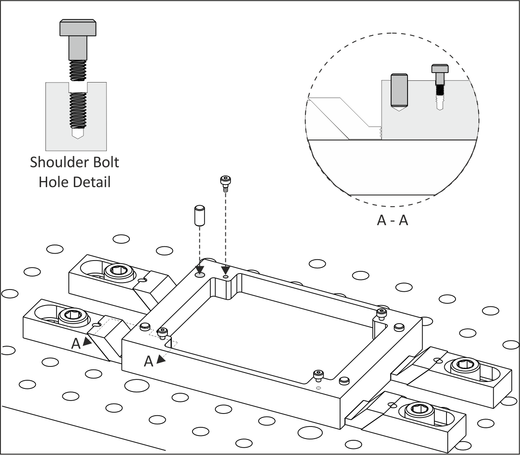 |
|
Figure A.37: Microwave Housing |
This project teaches the following skills:
This project is designed with features on the top and bottom that must match perfectly. Careful planning and setup is required to machine the part correctly, and avoid drilling into the table.
Large plate parts like this are usually clamped to the table because they will not fit in a standard vise, and vise pressure may cause the part to deform as material is removed. Clamping downward, rather than squeezing in a vise, prevents warping.
 |
|
Figure A.37: Microwave Housing |
Clamp the part directly to the table or sub plate. Add stock to create a flange. This is used to locate and hold the part when machining the bottom.
 |
|
Figure A.38: Microwave Housing, Top Side Setup |
Figure A.39 shows how the part looks after this operation, and how the dowel and shoulder bolt holes extend beyond the bottom of the part, but do not drill into the sub plate or table.
 |
|
Figure A.39: Front View - After Machining |
Machine the top complete.
|
Microwave Housing: Job 1 | |
|
| |
|
Datum: Upper-left corner of stock. | |
|
Op-1 Face |
Face Part avoiding clamps. |
|
Op-2 2D Rough |
Rough OD avoiding clamps. |
|
Op-3 2D Rough |
Rough pocket. |
|
Op-4 2D Finish |
Finish OD. Finish the part after roughing both the inside and outside so the part will stress relieve. |
|
Op-5 2D Finish |
Finish pocket. |
|
Op-6 3D Rough |
3D rough ramps. |
|
Op-7 3D Finish |
3D finish ramps. |
|
Op-8 2D Pocket |
Rough and finish pockets in bottom of pocket. |
|
Op-9 Ctr Drill |
Center drill all holes. |
|
Op-10 Drill |
Drill holes in flange for dowel pins used to locate the part for Job 2. |
|
Op-11 Drill |
Drill holes in flange. |
|
Op-12 Drill |
Drill holes in top face of part |
Figure A.40 shows a fixture plate used to machine the second side. The fixture has a cavity that the part fits into and the part is held by strap clamps on the flange.
Four dowel pin holes locate the part precisely. Notice the dowels cannot protrude above the finished thickness of the flange, so a facing tool can pass over without colliding (which would destroy the tool).
Four counter-bored holes match holes in the part. After facing, these holes are exposed, allowing shoulder bolts to be installed. These locate and clamp the part while the excess flange is cut away. Be sure to make the counterbore deep enough so the shoulder bolt will grip the part when tightened.
 |
|
Figure A.40: Fixture Plate Detail |
Machine the fixture plate given the parameters below.
|
Microwave Housing: Fixture Plate | |
|
| |
|
Datum: G55 XY is located at the center-face of dowel pin hole. Find this location by picking up a corner of the fixture plate stock, and then shifting G55 XY. This is important because this hole is used to precisely locate the Microwave Housing when it is fastened to this fixture. | |
|
Op-1 Face |
Face fixture plate avoiding clamps. |
|
Op-2 2D Pocket |
Rough and finish pocket. |
|
Op-3 Ctr Drill |
Center drill all holes. |
|
Op-4 Drill |
Drill holes for dowel pins. |
|
Op-5 Drill |
Drill holes for shoulder bolt threads. De-burr these holes so the chamfered edge will help guide the shoulder bolt so it slides into the hole and does not get hung on the sharp edge. |
|
Op-6 Drill |
Drill holes for shoulder bolt ground shoulder. |
|
Op-7 Tap |
Tap holes for shoulder bolts. |
Install dowel pins and then place part face down on the fixture. Ensure the dowel pins do not extend higher than the thickness of the part flange. Make sure the part is oriented properly so the features on the bottom mate with features on the top. Use Strap clamps to hold the part by the flange. Tap the part down with a rubber mallet, and use a feeler gauge to check for gaps between the fixture and face of the part.
 |
|
Figure A.41: Locate Part on Fixture |
Face the bottom of the part to thickness. Also machine the pocket and slot features in the bottom. Hopefully you remembered to sink the dowel pins deep enough so the tool faces over them without contacting. Notice how the dowel pins and holes for the shoulder bolts are now exposed.
|
Microwave Housing: Face and Machine Bottom Features | |
|
| |
|
Datum: Use same datum as fixture plate. | |
|
Op-1 Face |
Face part. |
|
Op-2 2D Pocket |
Rough and finish pocket. |
Install the shoulder bolts that are used to secure the part while the flange is cut away. You will probably have to de-burr the holes to get the bolts to slide in. Check to ensure the shoulder bolts actually grip the part. If not, then you did not make the counterbore deep enough (Step 3) and will need a washer.
Cut away the excess flange to finish the part. Leave all clamps in place during this operation to the flange will not lift during machining. Notice how close the tool passes to the dowel pins.
|
Microwave Housing: Job-3 Setup | |
|
| |
|
Datum: Use same datum as fixture plate. | |
|
Op-1 Contour |
Rough and finish OD of part to cut flange away. |